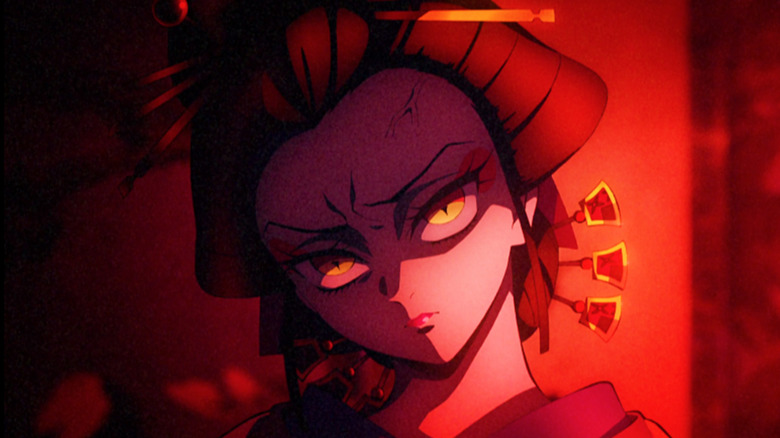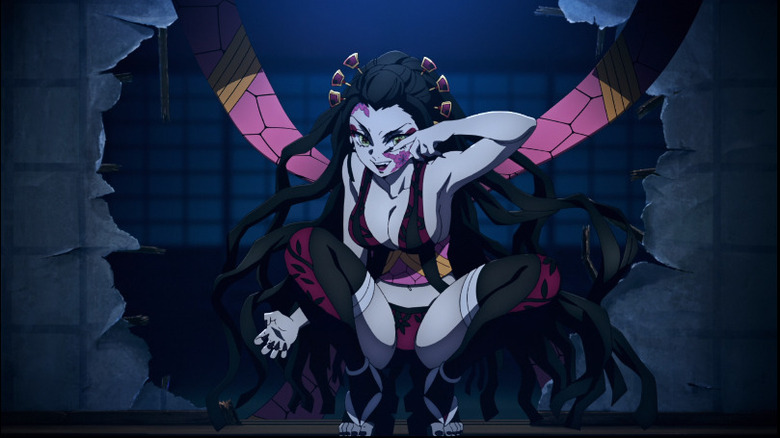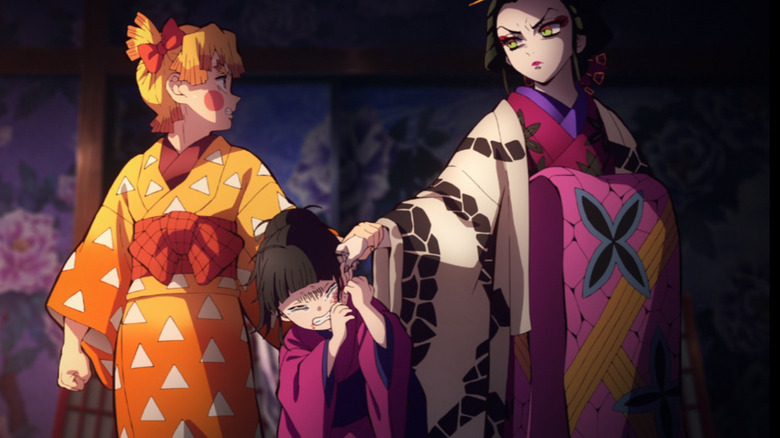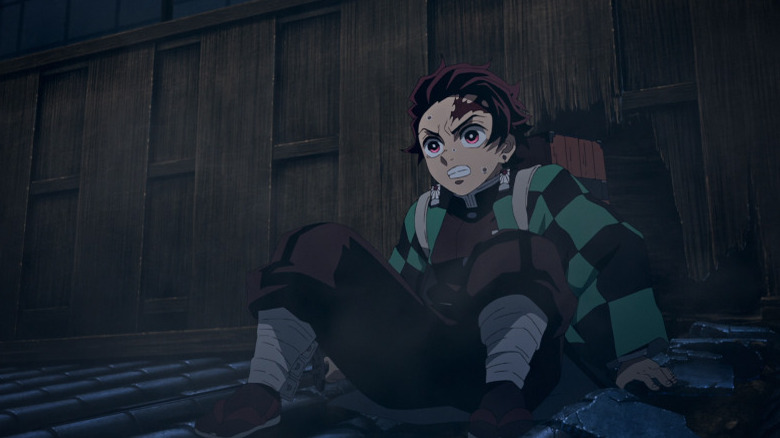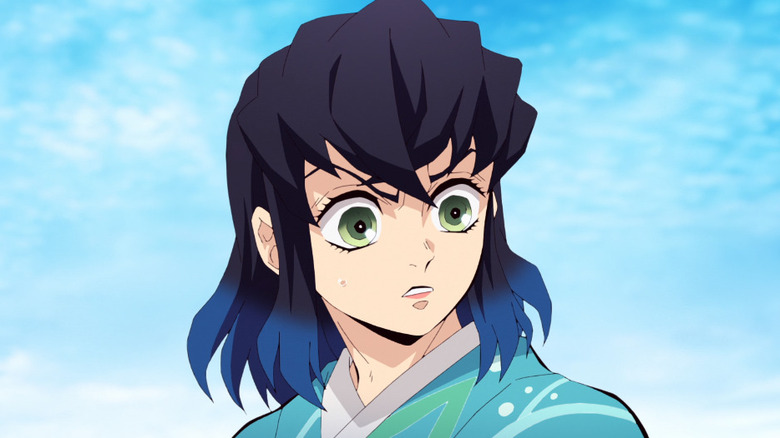Demon Slayer Season 2: Character Development Edition!
We're officially four episodes deep into Demon Slayer's Entertainment District Arc, which has taken place almost exclusively in a fictionalized, demon-infested version of Japan's historic Yoshiwara Red Light District (which is now Tokyo, Japan). Where the first three episodes of the arc focused on setting the scene, pushing the narrative, and character development, episode 4 saw a return to action and actual demon slaying.
While my previous "Demon Slayer" reviews focused on one episode each, but due to the holidays and the fact that episode 3 felt criminally short anyway, I'm doing a juicy, double-stuffed review that goes over the events of the episodes 3 and 4. Let's get into it!
New Demon Reveal: Daki
In episode 3, titled "What Are You?" the demon that has been hiding out in Yoshiwara is finally revealed. Somewhat unsurprisingly, she has been working as an Oiran in the same house that Zenitsu was "sold" to. The demon's name is Daki, but she has been disguising herself as a beautiful human for decades, always choosing aliases that contain the word "hime." Her current alias is Warabihime. Interestingly, "hime" is the Japanese word for "princess" or a woman of nobility. It can also be used to describe beautiful women, so it makes sense that a demon as vain and narcissistic as Daki would choose to use it in all of her human disguises.
Much of episode 3 focuses on Daki's characterization, and we learn that in addition to her insane levels of vanity and obsession with beauty — she won't even eat humans that she considers "ugly," opting to simply kill them instead — she is also incredibly cruel. Even when she is working as an Oiran in her human disguise, her cruelty is so severe and legendary that she often drives those around her to run away or commit suicide in order to escape her malice.
The only individual she is shown to have any respect for so far is the demon lord himself, Muzan Kibutsuji, from whom she seems to crave praise and validation, even going so far as to become noticeably subservient in his presence — a far cry from cry from her interactions with literally everyone else we've seen her with.
Daki commands such authority that even the house owners bow to her, cowering in fear of her wrath. In fact, everyone who is forced to live under the same roof appears to be terrified of her, with the exception of a newly refocused Zenitsu.
Zenitsu is Brave, Actually
Despite my long-held disdain for Zenitsu, I have to point out that he is a somewhat relatable character in that his emotions and reactions to things going on around him are realistic. I give him a lot of crap for his cowardice, but he has every right to be terrified. He readily admits to being afraid and is working on combating his fears in order to do what's right. Seeing that growth in his first encounter with Daki was awesome.
The yellow-haired electro-boy not only managed to regain his focus and remember the task at hand, but he does so just in time to defend a defenseless girl from Warabihime/Daki without hesitation. Where the Zenitsu of season 1 may have run away, the new and improved Zenitsu was ready to protect and attack if need be, and he didn't have to be unconscious this time to do it. It looks like he's growing up after all.
Given his current growth and borderline supernatural survival instincts that we saw in the Mugen Train Arc, Zenitsu stands a good chance of making it out of Daki's clutches alive and well, though I do wonder if Daki's aesthetic appeal will have any impact on his judgment or interactions with her in the coming episodes. Either way, Zenitsu is officially off my s**tlist. You know, for now.
Tanjiro Is Disobedient — Good!
As far as other characters, we get to learn a little more about each of them in episodes 3 and 4 as well. For Tanjiro, the impact of Rengoku's death is still strong, shown through his refusal to leave Yoshiwara even after Tengen tells both him and Inosuke that there's no shame in leaving, and that survival is the true victory at this point. Interestingly, this is also an example of Tanjiro being disobedient in order to serve the greater good, and there were several moments so far in this season that made a point to point out how Tanjiro's honesty and obedience were almost a hinderance for him and the mission. It looks like Zenitsu isn't the only one doing displaying meaningful growth and character development.
Tanjiro's strengthened resolve is even more clear during his battle with Daki. As someone who has their own struggles with fear and anxiety, it was really cool to see Tanjiro pull himself out of a defeatist mindset by addressing and countering the negativity and self-doubt that threatened to overtake him after Daki knocked the wind out of him.
The scene was particularly powerful to me on a personal level because his process for regaining his composure in the face of difficultly was not unlike my own. He recognized the root of the issue, got up, and ultimately decided to keep fighting despite the odds because survival was the only option. It was a very relatable moment, and perfectly illustrated the kind of heart and humanity that makes "Demon Slayer" stand out from other shonen anime. The elements of hope feel realistic as opposed to forced, as does the character growth.
Tegen & Inosuke
Since this has turned into an examination of character growth in the Red-Light District Arc, let's go ahead and look at Tengen and Inosuke. Where Tengen came off as an arrogant, inconsiderate douchebag in the first episode, by episode 4 he has proven to be caring and capable of remorse and humility. This is particularly evident in his merciful dismissal of and apology to Tanjiro and Inosuke when he informs them of Zenitsu's disappearance. He acknowledges that he has somewhat selfishly put their lives at risk because he was so focused n rescuing his wives, and he doesn't berate them for being weaker or seemingly incapable of handling the mission. Instead, he tells them that survival can also be a victory, and that he'd rather they return home to safety so he can complete the mission alone as opposed to further exposing them to danger in Yoshiwara. He also shows a very enthusiastic Inosuke some kindness by entrusting him with "muscle mice," which was really cute and reminded me that "Demon Slayer" is technically considered children's entertainment in its original country of Japan, despite the darker themes and violence that color so much of the story.
Speaking of Inosuke, his intelligence continues to become more apparent. He's not just a dual-wielding, impulsive wild boy with no home training; he's capable of more strategic thinking and thoughtful heroism than he was when he was first introduced in season 1. During the rooftop exchange with Tanjiro in episode 4, it becomes obvious that their friendship and experiences thus far have had a positive impact on Inosuke.
Overall, things are certainly picking up in Demon Slayer's Entertainment District Arc. While I'm grateful for the fact that we finally got another fight scene, I'm just as happy that so much time has been dedicated to showcasing the personal growth and depth of the characters we've come to know over the course of the series. That said ... when are gonna get some more Nezuko action? That poor girl has spent like 98% of this arc in a box, so I hope we get to see her again soon in the next episode.
